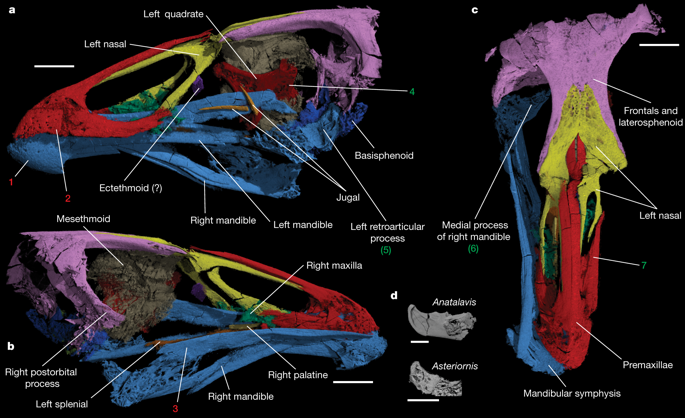Nature ( IF 50.5 ) Pub Date : 2020-03-18 , DOI: 10.1038/s41586-020-2096-0 Daniel J Field 1 , Juan Benito 1, 2 , Albert Chen 1, 2 , John W M Jagt 3 , Daniel T Ksepka 4

|
Our understanding of the earliest stages of crown bird evolution is hindered by an exceedingly sparse avian fossil record from the Mesozoic era. The most ancient phylogenetic divergences among crown birds are known to have occurred in the Cretaceous period1,2,3, but stem-lineage representatives of the deepest subclades of crown birds—Palaeognathae (ostriches and kin), Galloanserae (landfowl and waterfowl) and Neoaves (all other extant birds)—are unknown from the Mesozoic era. As a result, key questions related to the ecology4,5, biogeography3,6,7 and divergence times1,8,9,10 of ancestral crown birds remain unanswered. Here we report a new Mesozoic fossil that occupies a position close to the last common ancestor of Galloanserae and fills a key phylogenetic gap in the early evolutionary history of crown birds10,11. Asteriornis maastrichtensis, gen. et sp. nov., from the Maastrichtian age of Belgium (66.8–66.7 million years ago), is represented by a nearly complete, three-dimensionally preserved skull and associated postcranial elements. The fossil represents one of the only well-supported crown birds from the Mesozoic era12, and is the first Mesozoic crown bird with well-represented cranial remains. Asteriornis maastrichtensis exhibits a previously undocumented combination of galliform (landfowl)-like and anseriform (waterfowl)-like features, and its presence alongside a previously reported Ichthyornis-like taxon from the same locality13 provides direct evidence of the co-occurrence of crown birds and avialan stem birds. Its occurrence in the Northern Hemisphere challenges biogeographical hypotheses of a Gondwanan origin of crown birds3, and its relatively small size and possible littoral ecology may corroborate proposed ecological filters4,5,9 that influenced the persistence of crown birds through the end-Cretaceous mass extinction.
中文翻译:

来自欧洲的晚白垩纪新鸟氨酸阐明了冠鸟的起源
中生代极其稀少的鸟类化石记录阻碍了我们对冠禽进化早期阶段的理解。已知冠禽最古老的系统发育分歧发生在白垩纪1,2,3,但冠禽最深亚分支的干系代表——古颚科(鸵鸟和近亲)、加隆塞亚科(陆禽和水禽)和Neoaves(所有其他现存的鸟类)——从中生代开始就不为人知了。因此,与生态学4,5,生物地理学3,6,7和分歧时间1,8,9,10相关的关键问题祖冠鸟仍未得到答复。在这里,我们报告了一种新的中生代化石,它的位置接近于鸡冠鸟的最后一个共同祖先,填补了冠鸟早期进化史中的一个关键系统发育空白10,11。Asteriornis maastrichtensis , 根。等人。11 月 11 日,来自比利时的马斯特里赫特时代(66.8-6670 万年前),其代表是一个几乎完整的、三维保存的头骨和相关的颅后元素。该化石代表了中生代中唯一得到良好支持的冠鸟之一12,并且是第一只具有良好颅骨遗骸的中生代冠鸟。马斯特里希特鱼展示了以前未记录的鸡形(陆禽)样和鹅形(水禽)样特征的组合,并且它与先前报道的来自同一地点的鱼龙类分类群一起存在13提供了皇冠鸟和鸟类同时出现的直接证据干鸟。它在北半球的出现挑战了冠禽起源于冈瓦那的生物地理假设3,其相对较小的尺寸和可能的沿海生态学可能证实了提出的生态过滤器4,5,9影响冠禽在白垩纪末期的持久性灭绝。









































 京公网安备 11010802027423号
京公网安备 11010802027423号